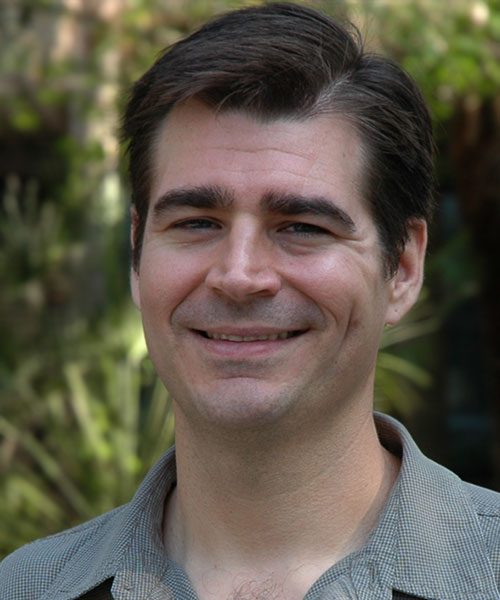Education
- Postdoctoral Fellow Ohio State University, 2004
- University of Arizona, Insect Science, Ph. D., 2003
- Florida State University, 1996
Research Responsibilities
I am an evolutionary physiologist by training, and research in our group typically integrates mechanistic perspectives from biochemistry, cell biology, and genetics to address important problems in ecology, evolution, and organismal biology from both basic sciences and applied agricultural perspectives. In recent years we have studied: 1) genetic and physiological architecture of local adaptation - especially hardiness to environmental stress, 2) rapid life history evolution - especially life history timing, 3) life history plasticity – especially with regard to reproductive timing, diapause, and aging, and 4) mechanisms underlying male performance and sexual selection. Our work has applications from understanding the generation of biodiversity and potential for adaptation in the face of climate change to improvement of techniques for insect pest management through biological control and pesticide-free post harvest treatments for fruits, vegetables, and other commodities.
Teaching Responsibilities
I have the pleasure of teaching a graduate course in insect physiology both on campus and through distance delivery every year, as well as other offerings like coursework in physiological ecology and presentation/professional skills.
Selected Publications
- Williams, C.M., M. Watanabe, M. Guarracino, M.B. Ferraro, A.S. Edison, T.J. Morgan, A. Boroujerdi, and D.A. Hahn. 2014. Cold adaptation shapes the robustness of metabolic networks in Drosophila melanogaster. Evolution. In Press
- Clemmensen, S.F., and D.A. Hahn. 2014. Dormancy cues alter insect temperature-size relationships. Oecologia. In Press. DOI 10.1007/s00442-014-3094-4
- Knutson, A., A. Mukherjee, D.A. Hahn, and K.M. Heinz. 2014. Biological control of giant salvinia (Salvinia molesta) in a temperate region: cold tolerance and low temperature oviposition of Cyrtobagous salviniae. BioControl. In Press. DOI 10.1007/s10526-014-9617-4
- Lopez-Martinez, G., J.E. Carpenter, S.D. Hight, and D.A. Hahn. 2014. Low-oxygen atmospheric treatment improves the performance of irradiation-sterilized male cactus moths used in SIT. Journal of Economic Entomology. 107:185-197. DOI: http://dx.doi.org/10.1603/EC13370
- Lopez-Martinez, G. and D.A. Hahn. 2014. Early-life hormetic treatments decrease irradiation-induced oxidative damage, increase longevity, and enhance sexual performance during old age in the Caribbean fruit fly. PLoS One 9(1): e88128. doi:10.1371/journal.pone.0088128
- Wadsworth, C. B., W. A. Woods, D. A. Hahn, and E. B. Dopman. 2013. One phase of the dormancy developmental pathway is critical for the evolution of insect seasonality. Journal of Evolutionary Biology 26:2359-2368.
- Hatle, J. D., J. W. Kellenberger, E. Viray, A. M. Smith, and D. A. Hahn. 2013. Life-extending ovariectomy in grasshoppers increases somatic storage, but dietary restriction with an equivalent feeding rate does not. Experimental Gerontology 48:966-972.
- Teets, N.M., J.T. Peyton, G.J. Ragland, H. Colinet, D. Renault, D.A. Hahn, and D.L. Denlinger. 2013. Uncovering molecular mechanisms of cold tolerance in a temperate flesh fly using a combined transcriptomic and metabolomic approach. Physiological Genomics, 44:764-767.
- Ragland, G.J., S.B. Sim, S. Goudarzi, J.L. Feder, and D.A. Hahn. 2012. Environmental interactions during host race formation: host fruit environment moderates a seasonal shift in phenology in host races of Rhagoletis pomonella. Functional Ecology, 26:921-931.
- Lopez-Martinez, G., and D.A. Hahn. 2012 Short-term anoxic conditioning hormesis boosts antioxidant defenses, lowers oxidative damage following irradiation, and enhances male sexual performance in the Caribbean fruit fly, Anastrepha suspensa. Journal of Experimental Biology, 215:2150-2161.
- Ragland, G.J., S.P. Egan, J.L. Feder, S.H. Berlocher, and D.A. Hahn. 2011. Developmental trajectories of gene expression reveal candidates for diapause termination, in the apple maggot fly, Rhagoletis pomonella. Journal of Experimental Biology. 214:3948-3959.
- Judd, E.B., M. Drewery, F.J. Wessels, D.A. Hahn, and J.D. Hatle. 2011. Ovariectomy in grasshoppers increases somatic storage, but proportional allocation of ingested nutrients to somatic tissues is unchanged. Aging Cell. 10:972-979.
- Diaz, R., W.A. Overholt, D.A. Hahn, A.C. Samoyoa. 2011. Diapause Induction in Gratiana boliviana (Coleoptera: Chrysomelidae), a Biological Control Agent of Tropical Soda Apple in Florida. Annals of the Entomological Society of America. 104:1319-1326.
- Wessels, F.J., R.B. Kristal, F. Netter, J.D. Hatle, and D.A. Hahn. 2011. Does it Pay to Delay? Flesh Flies Show Adaptive Plasticity in Reproductive Timing. Oecologia. 165:311-320.
- Hahn, D.A., and D.L. Denlinger. 2011. Energetics of Diapause. Annual Review of Entomology. 56:103-121.
- Ragland, G.J., D.L. Denlinger, and D.A. Hahn. 2010. Mechanisms of suspended animation are revealed by transcript profiling of diapause in the flesh fly. Proceedings of the National Academy of Sciences. 107:14909-14914.
- Wessels, F.J., and D.A. Hahn. 2010. Carbon 13 discrimination during lipid biosynthesis varies with dietary concentration of stable isotopes: implications for stable isotope analysis. Functional Ecology. 24:1017-1022.
- Hahn, D.A., L.N. James, K.R. Milne, and J.D. Hatle. 2008. Life history plasticity after attaining a dietary threshold for reproduction is associated with protein storage in flesh flies. Functional Ecology 22: 1081-1090.
- Hahn, D.A., and D.L. Denlinger. 2007. Meeting the energetic demands of insect diapause: nutrient storage and utilization. Journal of Insect Physiology 53: 760-773.
To see my complete curricula vitae in PDF format, click here.
